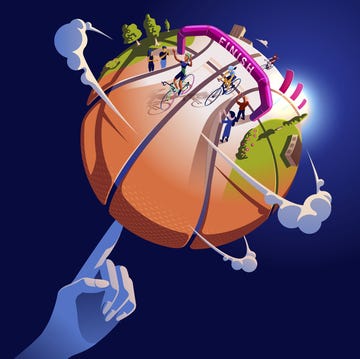How many of us grab an espresso shot before a ride to stay sharp or pop an ibuprofen at night to ease next-day soreness? Maybe you add a scoop of creatine to your post-ride shake or beta-alanine for recovery. Perhaps you’ve even tried ketones for an extra fuel boost or considered perfectly legal products like EPO Boost, often advertised in cycling magazines like this one and beyond. Some cyclists even take it a step further, using IV drips and oxygen bars to enhance performance and speed up recovery.
The point is that over-the-counter drugs and supplements seem to get more and more woven into the routines of cyclists and everyday athletes alike. But where do we draw the line in cycling culture between what’s acceptable and what’s pushing the boundaries? When does a substance or a medical treatment go from being simply supplementary to crossing into the realm of cheating?
“Over-Medicalization” of Pro Cyclists
“Pharmacology and human nature being what they are, it would be very naive to think that cycling has become completely clean,” Olivier Rabin, Director of Science and Medicine at the World Anti-Doping Agency (WADA), told Radio France as part of an investigation examining this very question.
Led by French journalist Géraldine Hallot, the report published on October 26 looks at the “over-medicalization” of athletes in professional cycling—a trend that appears to push the sport toward artificially sustained, high-level endurance. The report scrutinizes the boundaries between authorized medical practices and what could be termed “legal doping,” offering insights from a range of experts across the cycling world.
The investigation begins by questioning the growing dominance of Tadej Pogačar, whose extraordinary performances have sparked rising suspicion, and it examines whether recent advancements in medical equipment, dietary supplements, and genetic science have created a competitive landscape that current anti-doping regulations are not equipped to oversee.
The piece includes expert insights from sources such as Alexys Brunel, a French cyclist and former teammate of Pogačar at UAE Team Emirates; an anonymous team doctor from a French WorldTour team; Emmanuel Brunet, researcher and performance manager at the French Cycling Federation; and Rabin (quoted above), director of science and medicine at WADA, among others.
Concerning practices flagged by the report include the overuse of painkillers and anti-inflammatory drugs, widespread Therapeutic Use Exemptions (TUEs) for substances like asthma medications, reliance on ketone supplements, the use of carbon-monoxide recycling devices, microdosing of EPO and other substances, and potential genetic manipulation or “gene doping.” While many of these practices are technically within legal and regulatory limits and available to both amateurs and professionals, collectively, they reveal a culture that prioritizes wins at any cost—even at the potential expense of the athletes’ health and fair competition.
“All the drugs that take away pain, that allow you to relax, to eliminate contractures, to recover a little faster... All these authorized products, put together, become doping,” Jean-Pierre Verdy, former director of the French Anti-Doping Agency’s testing department, told Radio France.
This investigation is critical because it exposes a complex “gray area” in cycling, where legal yet performance-enhancing techniques blur the lines between fair play and artificial advantage. It raises concerns not only about competitive fairness, but also about the ethical impact of using athletes to advance an “arms race” in medicine and technology.
“We are no longer [searching for] a little pastoche (‘boost’ or ‘pick me up’) because we have a bad time. We are in the implementation of a medical protocol and in the search for artificial performance,” Eric Boyer, former rider and manager, told Radio France on the medicalization of cycling.
Where to Draw the Line
It’s difficult not to question the notion of “authentic” athleticism we hold so dearly. Sometimes, it feels like what really needs examination is our own naivete—the belief that rigorously policing these practices is worth the sport’s time and resources, especially with larger issues like gender inequality, sustainability, and sportswashing demanding attention. But if the line must be drawn somewhere, perhaps it starts with the question of intention and health: Are these methods simply supporting basic recovery and health, or are they pushing athletes toward artificially enhanced performance that changes the nature of the sport?
As these methods become more normalized, young cyclists may feel pressured to adopt them to stay competitive. And while some supplements, like caffeine and vitamin C, are widely accepted as benign aids to well-being, others—like EPO and pain killers like Tramadol—are recognized as unnatural boosts that distort fair competition. The gray area lies in between, where practices like creatine, ketone supplements, IV drips, and even altitude training walk a fine line between recovery support and “legal doping.”
For me, this line isn’t just about legality, but about protecting athletes’ health and the ethos of the sport. While supplements that support immunity or general wellness feel like fair game, we must draw the line when enhancements prioritize performance gains over the athlete’s natural ability. Otherwise, we risk accepting a culture where victory is achieved through medical intervention rather than authentic athletic skill.













